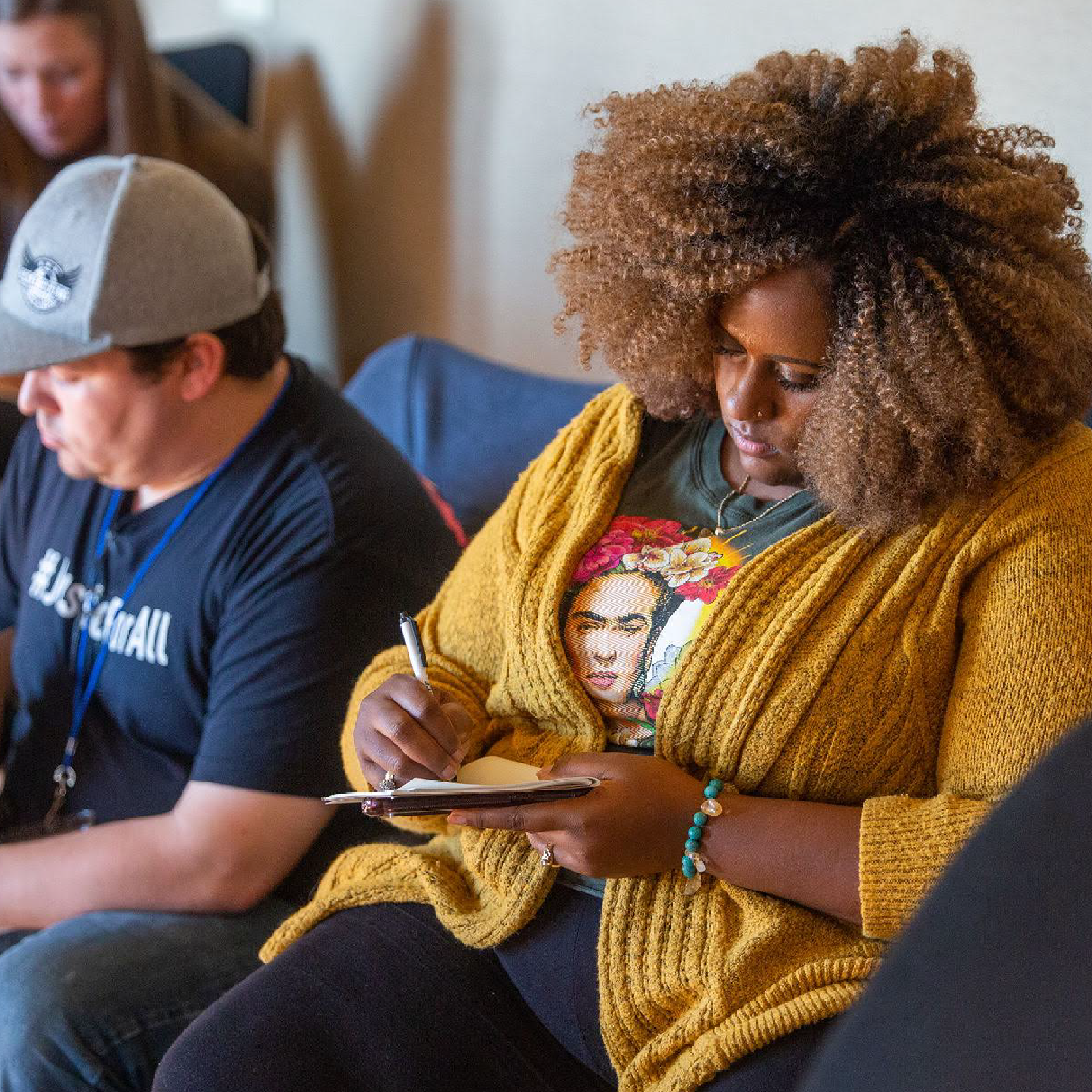The Importance of Receiving Pre-Training
Preparing your organization to implement a restorative justice diversion program requires more than just reading and utilizing this toolkit. If you are interested in learning more about training and technical assistance opportunities from the Restorative Justice Project at Equal Justice USA, please fill out the form in Step 3: Stay Connected of this toolkit. There are also many other organizations that you can receive trainings from around restorative justice, circle processes, implicit bias, and other important topics. Your organization can also gain a great deal of experience and relationship through holding circles in your community. Responsibly introducing RJD to your community requires learning about the history and fundamental principles of circle process and restorative justice, as well as gaining intimate knowledge of how our criminal legal system functions and its history. You learned about this at length in Step 1A: Youth Criminalization, and we encourage you to review the additional resources provided in that step to deepen your knowledge of the criminal legal system.
Additionally, it is essential to understand implicit bias and privilege—how they inform our interactions with others, as well as how they create and uphold certain practices, policies, and procedures. Developing a program that maintains and sustains a liberation framework can only happen when staff actively and self-reflectively engage with the realities of implicit bias, power, and privilege.
While our list of recommended organizations, associations, and websites is in no way exhaustive, it does provide a great starting point for conducting your own research on where to receive trainings and additional support. Although many of these organizations are California-based, their trainers may be available to travel. Of course, if there is a local restorative justice organization in your community that offers trainings, they could be your best option—both because local trainers cut down on travel costs and because they will have a better understanding of your local community. For more opportunities, check out the training and events calendar of the National Association of Community and Restorative Justice (NACRJ).
Training in Implicit Bias, Equity, and Privilege
- Circle Up Education
Designs and facilitates custom trainings in conflict resolution, diversity and equity, restorative practices, and professional development
Restorative Justice & Circle Process
- The Ahimsa Collective
Facilitates trainings in restorative justice, trauma healing, facilitation, and restorative approaches upon request
- California Conference for Equality and Justice
Provides training and technical assistance for building practitioners’ capacity to implement restorative justice practices internally in their policies, practices, and culture, and externally with the communities they serve
- Community Connections for Youth Institute Empowers grassroots faith and neighborhood organizations to develop effective community-driven alternatives to incarceration for youth
- Community Justice for Youth Institute
Provides training and technical assistance in restorative justice, peacemaking circles and circle facilitation
- Eastern Mennonite University’s Summer Peacebuilding Institute
Graduate school that publishes the Little Books of Justice & Peacebuilding series; offers professional education and training including STAR – Trauma Resilience Training and the Summer Peacebuilding Institute
- Honeycomb Justice A group of restorative and transformative justice facilitators, educators, and D&I specialists who offer trainings in restorative community building; advanced circling around identity, climate, and communal witnessing; restorative justice conferencing for inflamed structural/historical harm, and more
- Restorative Justice for Oakland Youth
Offers education, training and technical assistance, and launches programs with school, community, juvenile justice, and research partners
- Restorative Justice Training Institute
Offers training, coaching, curriculum development, research, and evaluation based in restorative practices for schools and youth organizations
- Spring Up
Hosts liberatory learning spaces through online classes, print materials and curriculum, retreats, and coaching on topics including facilitating liberatory education, gender liberation, community care and accountability, & conflict analysis
Juvenile Legal System
Contact your local legal aid center and request a meeting, presentation, or training on your local juvenile legal system and processes.
- The Annie E. Casey Foundation
Provides information on state and city juvenile legal system data with the option to create customized reports for your region
- Youth First Initiative Provides information on local efforts to close youth prisons and invest in community-based alternatives like restorative justice.
- National Youth Justice Network Provides training and support for BIPOC leaders invested in strengthening the national youth justice movement and transforming the youth justice system.
Hold Circles
Once trained in restorative justice and circle process, you’ll be able to hold circles. Spending time in this facilitation role is essential experience necessary before starting an RJD program. Spend as much time as you need in this step of the toolkit, learning alongside others in trainings and practicing restorative justice in your life. The next step of the toolkit helps you determine if an RJD program is truly aligned with your organization’s values and mission.
What If…?
What if there are no local restorative justice groups in our area and we can’t afford to pay for a national organization to come train us?
Let organizations know that you’re working through this toolkit with the aim of starting a diversion program, and find out if they have sliding scale prices for trainings. Another option to conserve funds is to send just a few staff members to a training, instead of asking the trainers to come to you, then have those staff members teach it out. A final suggestion is to set up a “training exchange.” Perhaps you are a restorative justice organization interested in receiving implicit bias training. Reach out to groups that offer implicit bias training and find out if they would be interested in receiving a training in restorative justice from your team in exchange for one in implicit bias by their team.
What if we are an organization that offers these types of trainings?
Fantastic, you can check some of these trainings off your list! Now, you can begin to brainstorm how content from your own trainings applies to restorative justice diversion and what supplementary topics you may want to seek training in to further strengthen the foundations of your RJD program.
